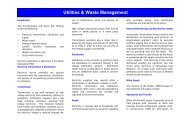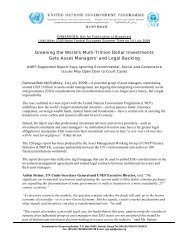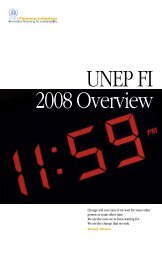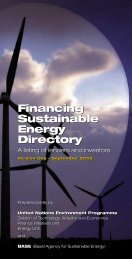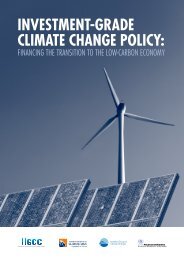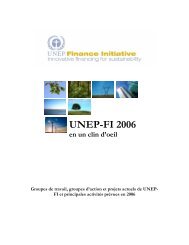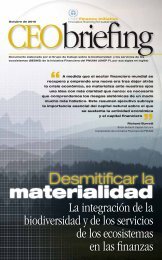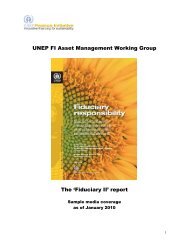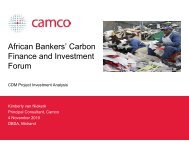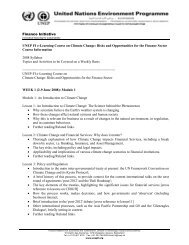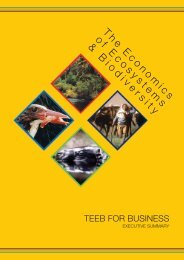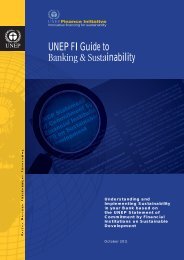Carbon 2009 Emission trading coming home - UNEP Finance Initiative
Carbon 2009 Emission trading coming home - UNEP Finance Initiative
Carbon 2009 Emission trading coming home - UNEP Finance Initiative
Create successful ePaper yourself
Turn your PDF publications into a flip-book with our unique Google optimized e-Paper software.
<strong>Carbon</strong> <strong>2009</strong><br />
surpluses may thus have been<br />
sold or swapped, with options<br />
attached in case carbon prices<br />
were to surge. A more general<br />
reason for this increase in options<br />
<strong>trading</strong> may simply be increased<br />
market maturation, spurred in<br />
part by financial institutions that<br />
facilitate EUA-CER swapping.<br />
Lower emissions also mean less<br />
of a need to borrow EUAs from a<br />
future year, but increased market<br />
maturity may counteract this<br />
tendency as companies seek to<br />
make the most of their allocated<br />
allowances.<br />
While there is no explicit<br />
mechanism for borrowing EUAs<br />
from future years, installations<br />
are in practice able to engage<br />
in borrowing from next year’s<br />
allocation in the EU ETS. This<br />
is because the free portion of<br />
EUAs for a given compliance year<br />
needs to be handed out by 28<br />
February of that year, whereas<br />
allowances for compliance with<br />
the previous year are only due to<br />
be surrendered by 30 April.<br />
Increased options<br />
<strong>trading</strong> in carbon<br />
markets<br />
Interestingly, the number of<br />
respondents reporting that their<br />
companies permit borrowing<br />
from the future, either with or<br />
without a limit, is somewhat<br />
down on last year, from 43 to<br />
37 percent (see Figure 3.9).<br />
However, the difference is<br />
not very large, notably if we<br />
exclude the substantial portion<br />
of respondents that do not know<br />
their company policy on this<br />
question. Respondents from the<br />
pulp and paper sector display<br />
the highest affirmative rate -- 63<br />
percent.<br />
24<br />
3.4 CDM<br />
In <strong>2009</strong>, the economic downturn<br />
is likely to impact investments<br />
considerably in the project<br />
markets – the CDM and JI. In<br />
addition, post-2012 uncertainty<br />
and declining emissions in many<br />
countries will have an impact on<br />
the demand for CER and ERUs. To<br />
gauge the effect of the economic<br />
downturn on the CDM market,<br />
we asked respondents whether<br />
their companies had modified<br />
their purchasing or investments<br />
as a direct consequence of the<br />
slowdown. We also asked a<br />
more general question about<br />
planned company involvement<br />
in the CER market in <strong>2009</strong>.<br />
Figure 3.10 displays the answers<br />
to the first question. Here, 44<br />
percent of the respondents – and<br />
a full 60 percent of those with<br />
substantive replies (excluding<br />
“not applicable”) reported that<br />
their companies had scaled<br />
down, delayed or cancelled<br />
carbon credit project investments.<br />
The corresponding number for<br />
carbon credit purchases was 53<br />
percent of substantive answers.<br />
As financing dries up, and prices<br />
for primary and secondary CERs<br />
decline, these responses are in<br />
line with what one can expect<br />
in the current market situation.<br />
As noted above, we forecast a<br />
significant drop in CDM (and JI)<br />
investments, with a pCER volume<br />
down 45 percent on 2008, to 300<br />
Mt in <strong>2009</strong>. Low prices both in the<br />
primary and secondary markets<br />
reduce the incentives to invest;<br />
post-2012 uncertainty and the<br />
fact that the end of the first Kyoto<br />
commitment period is less than<br />
four years away also contribute to<br />
a lack of interest in new projects.<br />
Nevertheless, 27 percent and<br />
23 percent, respectively, answer<br />
that the financial and economic<br />
downturn has not influenced their<br />
carbon credit purchases or carbon<br />
credit project investments. Some<br />
Figure 3.10: Cancelling credit?<br />
“To what extent - if at all - has the financial and economic downturn<br />
influenced your operations in the following areas?” Companies <strong>trading</strong><br />
EUAs/CERs/ERUs/RGAs. N=1219.<br />
cancelled<br />
delayed<br />
scaled down<br />
not influenced at all<br />
increased<br />
not applicable<br />
Source: Point <strong>Carbon</strong><br />
0% 5% 10% 15% 20% 25% 30%<br />
<strong>Carbon</strong> credit project investments<br />
<strong>Carbon</strong> credit purchases<br />
All rights reserved © <strong>2009</strong> Point <strong>Carbon</strong>



